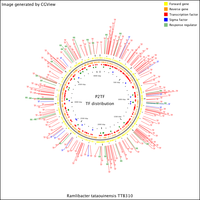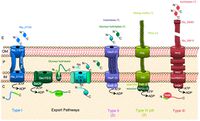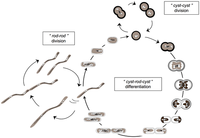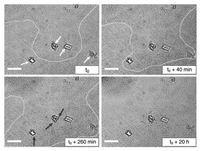Ramlibacter tataouinensis NEUF2011: Difference between revisions
| (46 intermediate revisions by the same user not shown) | |||
| Line 8: | Line 8: | ||
===Higher order taxa=== | ===Higher order taxa=== | ||
'''Domain''': Bacteria | '''Domain''': Bacteria <br> | ||
'''Phylum''': Proteobacteria | '''Phylum''': Proteobacteria <br> | ||
'''Class''': Betaproteobacteria | '''Class''': Betaproteobacteria <br> | ||
'''Order''': Burkholderiales | '''Order''': Burkholderiales <br> | ||
'''Family''': Comamonadaceae | '''Family''': Comamonadaceae | ||
| Line 20: | Line 20: | ||
'''Genus''': Ramlibacter | '''Genus''': Ramlibacter <br> | ||
'''Species''': Tataouinensis | '''Species''': Tataouinensis | ||
| Line 31: | Line 31: | ||
==Genome structure== | ==Genome structure== | ||
[[File:CP000245.png|200px|thumb|left|Genome of ''Ramlibacter tataouinensis'' [7]]] | [[File:CP000245.png|200px|thumb|left|'''Figure 1''': Genome of ''Ramlibacter tataouinensis'' [7]]] | ||
The genome of ''Ramlibacter tataouinensis'' is composed of a singular circular chromosome that is 4,070,194 base pairs with a guanine and cytosine content of seventy percent, among the highest of proteobacteria. Additionally, the average gene length is 964 base pairs. ''R. tataouinensis'' has genetic characterstics that greatly resemble those of aerobic chemo-organotrophic bacterial strain. Furthermore, this strain, ''R. tataouinensis'' TTB310 contains genes that encode for proteins to protect the organism against toxicity of reactive oxygen species. It is the first to reveal the ''kai''C gene that is rarely found within non-photosynthetic bacteria. The gene functions similarly to photosynthetic bacteria by allowing the organism to create an internal molecular clock to coordinate its cell cycle based on the availability of water found in dry and hot desert environments. [1] | The genome of ''Ramlibacter tataouinensis'' is composed of a singular circular chromosome that is 4,070,194 base pairs with a guanine and cytosine content of seventy percent, among the highest of proteobacteria (see '''Figure 1'''). Additionally, the average gene length is 964 base pairs. ''R. tataouinensis'' has genetic characterstics that greatly resemble those of aerobic chemo-organotrophic bacterial strain. Furthermore, this strain, ''R. tataouinensis'' TTB310 contains genes that encode for proteins to protect the organism against toxicity of reactive oxygen species. It is the first to reveal the ''kai''C gene that is rarely found within non-photosynthetic bacteria. The gene functions similarly to photosynthetic bacteria by allowing the organism to create an internal molecular clock to coordinate its cell cycle based on the availability of water found in dry and hot desert environments. [1] | ||
==Cell structure and metabolism== | ==Cell structure and metabolism== | ||
''R. tataoiunensis'' | [[File:Pone.0023784.jpeg|200px|thumb|right|'''Figure 2''' Representation of the envelope transport system of ''R. tataoiunensis'' [1]]] | ||
''R. tataoiunensis'' is gram-negative. Coccoid cells are enclosed by a thick capsule, have white sperical polyhydroxyalkanoate granules in the cytoplasm, and exhibit long-term resistance to desiccation. Rod-like cells are nanometric (0.2 micron diameter), vegetative, and also have spherical granules. Neither type of cell has flagella, but rods are motile via a gliding mechanism. [3] This mechanism can be seen in a schematic representation in ('''Figure 2'''), the IV pili | |||
that is made up of different pillins and three different PilB paralogs are present and are thought to be involved in the gliding motion of ''R. tataoiunensis'' [1]. | |||
Carbon sources for ''R. tataoiunensis'' include acetate, β-hydroxybutyrate, γ-hydroxybutyrate, pyruvate, propionate, and DL-lactate. | Standard biochemical tests have been conducted on ''R. tataoiunensis''. Bacteria tested positive for beta-glucosidase and reduction of nitrate to nitrite, but negative on most tests, including indol production, urease, glucose fermentation, gelatin hydrolysis, and beta-galactosidase. Carbon sources for ''R. tataoiunensis'' include acetate, β-hydroxybutyrate, γ-hydroxybutyrate, pyruvate, propionate, and DL-lactate. ''R. tataoiunensis'' is aerobic and chemo-organotrophic. The optimal pH and temperature for growth are 7.5 and 30 °C, respectively, and growth factors are required. This bacterium exhibits weak growth at 37 °C. [3] | ||
''R. tataoiunensis'' is aerobic and chemo-organotrophic. The optimal pH and temperature for growth are 7.5 and 30 °C, respectively, and growth factors are required. This bacterium exhibits weak growth at 37 °C. | |||
[3] | |||
==Ecology== | ==Ecology== | ||
'' | [[File:Ramlibacter_cell_cycle.png|200px|thumb|left|'''Figure 3''': Model of ''Ramlibacter tataouinensis'' cell cycle [1]]] | ||
''Ramlibacter tataouinensis'' was first isolated in the Tatauoine meteorite in the desert of South Tunisia and is now known as the "desert bacterium" due to its unique cell cycle [5]. Desert habitats are considered one of the most extreme environments for microbial organisms because of the scarcity of water. Due to little rain and large variations in temperature, mineral content, and high levels of UV radiation, desert microbes need to be highly adapted for the extreme environment. ''Ramlibacter tataouinensis'' survives in this habitat through taking on the two forms of desiccation-resistant cysts and motile rods [1][8]. The cell cycle of ''R. tataouinensis'' is shown in '''Figure 3'''. The cycle consists of two phases, a cyst-to-cyst division step and a cyst-rod-cyst differentiation (cyst-to-rod, followed by rod-to-cyst). The complex cyst-to-rod division step occurs at the periphery of the colony. Cyst-like cells contain extracellular polymeric substances (EPS), which allow the cysts to adhere to solid surfaces and confer desiccation-resistance. These EPS are lysed during rod-to-cyst conversion and is synthesized during the cyst-to-rod phase. The strikingly high guanine-cytosine content of the genome of ''R. tataouinensis'' also confers protection from desiccation in high temperature. [1] | |||
==Pathology== | ==Pathology== | ||
Ramlibacter tataouinensis is not a pathogenic organism and no research has shown Ramlibacter tataouinensis to exist in any organism. | Ramlibacter tataouinensis is not a pathogenic organism and no research has shown Ramlibacter tataouinensis to exist in any organism. [1] | ||
==Current Research== | ==Current Research== | ||
| Line 62: | Line 59: | ||
Current research on ''Ramlibacter tataouinensis'' revolves around its ability to survive in extreme desert conditions where water, minerals, and extreme UV radiation are all worries for microbial growth. Ongoing research has been done on its cell cycle which consists of two stages where it can be non-motile and then as desiccation resistant cysts. ''Ramlibacter tataouinensis'' blocks its cell cycle in the cyst production stage during the morning in order to protect itself from extreme heat and dryness. The second cycle activates during the night when the temperature drops and dew can form. Research on how ''Ramlibacter tataouinensis'' survives in desert conditions has shed light on how cell cycles in bacteria can reflect its molecular clock. [5] | Current research on ''Ramlibacter tataouinensis'' revolves around its ability to survive in extreme desert conditions where water, minerals, and extreme UV radiation are all worries for microbial growth. Ongoing research has been done on its cell cycle which consists of two stages where it can be non-motile and then as desiccation resistant cysts. ''Ramlibacter tataouinensis'' blocks its cell cycle in the cyst production stage during the morning in order to protect itself from extreme heat and dryness. The second cycle activates during the night when the temperature drops and dew can form. Research on how ''Ramlibacter tataouinensis'' survives in desert conditions has shed light on how cell cycles in bacteria can reflect its molecular clock. [5] | ||
'''The Cyst-Dividing Bacterium ''Ramlibacter tataouinensis'' TTB310 Genome Reveals a Well-Stocked Toolbox for Adaptation to a Desert Environment''' | |||
Other research on ''Ramlibacter tataouinensis'' has shown that bacteria can have circadian rhythms. This was discovered when researchers | Other research on ''Ramlibacter tataouinensis'' has shown that bacteria can have circadian rhythms. This was discovered when researchers experimented with altering amounts of UV radiation and duration of radiation on these bacteria. This endogenous circadian rhythm is given by gene kaiC which governs a molecular clock mechanism which alters cell cycle based on day and night, allowing the organism to respond to changes in water availability. [1] | ||
'''Biologically controlled precipitation of calcium phosphate by ''Ramlibacter tataouinensis'' ''' | |||
Research is also being done on ''Ramlibacter tataouinensis''’s circadian rhythm with respect to their fossilization. Due to the organisms affinity for minerals, when ''Ramlibacter tataouinensis'' is fossilized, researchers hope to be able to use crystallography and calcium and phosphorus ratios to determine temperature cycles in the search of past life on earth. [4] | Research is also being done on ''Ramlibacter tataouinensis''’s circadian rhythm with respect to their fossilization. Due to the organisms affinity for minerals, when ''Ramlibacter tataouinensis'' is fossilized, researchers hope to be able to use crystallography and calcium and phosphorus ratios to determine temperature cycles in the search of past life on earth. [4] | ||
| Line 69: | Line 72: | ||
==Cool Factor== | ==Cool Factor== | ||
[[File:Time laps.png|200px|thumb|left|'''Figure 4''': Optical Time Lapse Showing Differentiation Into Cysts [6]]] | |||
Additionally, in another study conducted by Benzara K. et al., suggests that ''Ramlibacter tataouinensis'' might engage in quorum sensing to differentiate between rod and cyst formation based on the crystals leading to a high density of rods | Bacteria are known to modify the mineral chemistry and alter their physiology based on their surface attachment sites. ''Ramlibacter tataouinensis'' is involved in the colonization and alteration of orthopyroxene crystals (Fe2 +, Mg2 + containing silicates) whose life cycle alternate between rods and spherical cysts. Studies have shown that when the rods differentiate into cysts and form microcolonies. These microcolonies can take place in the presences of crystals suggesting a vital interaction between crystals and colonizing bacteria. Benzerara K. et al., hypothesize that the interaction between the crystals and colonized bacteria is due to the ability of rods to sense the mechanical deformation of the agar surface that incorporates the crystals. This phenomenon has been observed and analyzed in Myxobacteria and has been named "elasticotaxis." [4] '''Figure 4''' depicts an optical time lapse micrograph of a colony of ''R. tataouinensis'' on pyroxene crystal differentiating from rod like structures to cysts. Initially, only rods are observed and ultimately cysts are observe on the pyroxene crystal in the last time point where time is 1,200 min [6]. | ||
Additionally, in another study conducted by Benzara K. et al., suggests that ''Ramlibacter tataouinensis'' might engage in quorum sensing to differentiate between rod and cyst formation based on the crystals leading to a high density of rods [6]. Furthermore, Benzara K. et al. also found that ''Ramlibacter tataouinensis'' is capable of consume complex organic ligands that are found on culture medium, pyroxene crystals, resulting in a dissolution. [6] | |||
==References== | ==References== | ||
| Line 87: | Line 92: | ||
[6] [http://www.ipgp.fr/files_lib/27_GeomicrobJ.pdf Benzerara, K., Barakat, M., Menguy, N., Guyot, F., de Luca, G., Audrain, C., Heulin, T. Experimental colonization and alteration of orthopyroxene by the pleomorphic bacteria ''Ramlibacter tataouinensis''. ''Geomicrobiology Journal''. 2004. Volume 21, p. 341-349.] | [6] [http://www.ipgp.fr/files_lib/27_GeomicrobJ.pdf Benzerara, K., Barakat, M., Menguy, N., Guyot, F., de Luca, G., Audrain, C., Heulin, T. Experimental colonization and alteration of orthopyroxene by the pleomorphic bacteria ''Ramlibacter tataouinensis''. ''Geomicrobiology Journal''. 2004. Volume 21, p. 341-349.] | ||
[7] Ramlibacter Tataouinensis TTB310. Photograph. CGView. Web. <http://www.p2tf.org/page.php?base=RamtaDB>. | [7] [http://www.p2tf.org/page.php?base=RamtaDB Ramlibacter Tataouinensis TTB310. Photograph. CGView. Web. <http://www.p2tf.org/page.php?base=RamtaDB>.] | ||
[8] [http://0-ehis.ebscohost.com.ilsprod.lib.neu.edu/eds/pdfviewer/pdfviewer?vid=2&hid=116&sid=6295f8df-e09c-42fd-8895-bcc6d7056de2%40sessionmgr104 Chanal, A., Chapon, V., Benzerara, K., Barakat, M., Christen, R., Achouak, W., Barras, F. and Heulin, T. The desert of Tataouine: an extreme environment that hosts a wide diversity of microorganisms and radiotolerant bacteria. ''Environmental Microbiology''. 2006. Volume 8, p. 514–525.] | |||
Edited by Maria Castano, Alexandra Tsolias, Rebecca Thibault, and Kevin Wu (students of Iris Keren) | Edited by Maria Castano, Alexandra Tsolias, Rebecca Thibault, and Kevin Wu (students of Iris Keren) | ||
Latest revision as of 02:55, 2 November 2011
A Microbial Biorealm page on the genus Ramlibacter tataouinensis NEUF2011
Classification
Higher order taxa
Domain: Bacteria
Phylum: Proteobacteria
Class: Betaproteobacteria
Order: Burkholderiales
Family: Comamonadaceae
Bacteria; Proteobacteria; Betaproteobacteria; Burkholderiales; Comamonadaceae; Ramlibacter; tataouinensis
Species
Genus: Ramlibacter
Species: Tataouinensis
Ramlibacter tataouinensis
Description and significance
R. tataouinensis was first isolated from South Tunisia in a semi-arid region. It is a pleomorphic gram-negative betaproteobacterium with both rod-shaped and spherical cells in pure culture (see Figure 1). It has a unique cell cycle in that its spherical (coccoid) cyst-like cells are very tolerant of desiccation and are capable of division by binary fission while its rod-shaped cells, while incapable of division, are motile and able to form colonies in new environments, where they revert back to desiccation-resistant spherical cells. This enables them to survive and migrate in dry desert environments. In addition, R. tataouinensis contains a high proportion of light-sensing proteins relative to other chemotrophic non-photosynthetic bacteria. These proteins, along with a circadian "hourglass", enable the bacteria to detect environmental cues that pertain to water availability. [1]
Genome structure
The genome of Ramlibacter tataouinensis is composed of a singular circular chromosome that is 4,070,194 base pairs with a guanine and cytosine content of seventy percent, among the highest of proteobacteria (see Figure 1). Additionally, the average gene length is 964 base pairs. R. tataouinensis has genetic characterstics that greatly resemble those of aerobic chemo-organotrophic bacterial strain. Furthermore, this strain, R. tataouinensis TTB310 contains genes that encode for proteins to protect the organism against toxicity of reactive oxygen species. It is the first to reveal the kaiC gene that is rarely found within non-photosynthetic bacteria. The gene functions similarly to photosynthetic bacteria by allowing the organism to create an internal molecular clock to coordinate its cell cycle based on the availability of water found in dry and hot desert environments. [1]
Cell structure and metabolism
R. tataoiunensis is gram-negative. Coccoid cells are enclosed by a thick capsule, have white sperical polyhydroxyalkanoate granules in the cytoplasm, and exhibit long-term resistance to desiccation. Rod-like cells are nanometric (0.2 micron diameter), vegetative, and also have spherical granules. Neither type of cell has flagella, but rods are motile via a gliding mechanism. [3] This mechanism can be seen in a schematic representation in (Figure 2), the IV pili that is made up of different pillins and three different PilB paralogs are present and are thought to be involved in the gliding motion of R. tataoiunensis [1].
Standard biochemical tests have been conducted on R. tataoiunensis. Bacteria tested positive for beta-glucosidase and reduction of nitrate to nitrite, but negative on most tests, including indol production, urease, glucose fermentation, gelatin hydrolysis, and beta-galactosidase. Carbon sources for R. tataoiunensis include acetate, β-hydroxybutyrate, γ-hydroxybutyrate, pyruvate, propionate, and DL-lactate. R. tataoiunensis is aerobic and chemo-organotrophic. The optimal pH and temperature for growth are 7.5 and 30 °C, respectively, and growth factors are required. This bacterium exhibits weak growth at 37 °C. [3]
Ecology
Ramlibacter tataouinensis was first isolated in the Tatauoine meteorite in the desert of South Tunisia and is now known as the "desert bacterium" due to its unique cell cycle [5]. Desert habitats are considered one of the most extreme environments for microbial organisms because of the scarcity of water. Due to little rain and large variations in temperature, mineral content, and high levels of UV radiation, desert microbes need to be highly adapted for the extreme environment. Ramlibacter tataouinensis survives in this habitat through taking on the two forms of desiccation-resistant cysts and motile rods [1][8]. The cell cycle of R. tataouinensis is shown in Figure 3. The cycle consists of two phases, a cyst-to-cyst division step and a cyst-rod-cyst differentiation (cyst-to-rod, followed by rod-to-cyst). The complex cyst-to-rod division step occurs at the periphery of the colony. Cyst-like cells contain extracellular polymeric substances (EPS), which allow the cysts to adhere to solid surfaces and confer desiccation-resistance. These EPS are lysed during rod-to-cyst conversion and is synthesized during the cyst-to-rod phase. The strikingly high guanine-cytosine content of the genome of R. tataouinensis also confers protection from desiccation in high temperature. [1]
Pathology
Ramlibacter tataouinensis is not a pathogenic organism and no research has shown Ramlibacter tataouinensis to exist in any organism. [1]
Current Research
Adaptation Secrets of the 'desert bacterium'
Current research on Ramlibacter tataouinensis revolves around its ability to survive in extreme desert conditions where water, minerals, and extreme UV radiation are all worries for microbial growth. Ongoing research has been done on its cell cycle which consists of two stages where it can be non-motile and then as desiccation resistant cysts. Ramlibacter tataouinensis blocks its cell cycle in the cyst production stage during the morning in order to protect itself from extreme heat and dryness. The second cycle activates during the night when the temperature drops and dew can form. Research on how Ramlibacter tataouinensis survives in desert conditions has shed light on how cell cycles in bacteria can reflect its molecular clock. [5]
The Cyst-Dividing Bacterium Ramlibacter tataouinensis TTB310 Genome Reveals a Well-Stocked Toolbox for Adaptation to a Desert Environment
Other research on Ramlibacter tataouinensis has shown that bacteria can have circadian rhythms. This was discovered when researchers experimented with altering amounts of UV radiation and duration of radiation on these bacteria. This endogenous circadian rhythm is given by gene kaiC which governs a molecular clock mechanism which alters cell cycle based on day and night, allowing the organism to respond to changes in water availability. [1]
Biologically controlled precipitation of calcium phosphate by Ramlibacter tataouinensis
Research is also being done on Ramlibacter tataouinensis’s circadian rhythm with respect to their fossilization. Due to the organisms affinity for minerals, when Ramlibacter tataouinensis is fossilized, researchers hope to be able to use crystallography and calcium and phosphorus ratios to determine temperature cycles in the search of past life on earth. [4]
Cool Factor
Bacteria are known to modify the mineral chemistry and alter their physiology based on their surface attachment sites. Ramlibacter tataouinensis is involved in the colonization and alteration of orthopyroxene crystals (Fe2 +, Mg2 + containing silicates) whose life cycle alternate between rods and spherical cysts. Studies have shown that when the rods differentiate into cysts and form microcolonies. These microcolonies can take place in the presences of crystals suggesting a vital interaction between crystals and colonizing bacteria. Benzerara K. et al., hypothesize that the interaction between the crystals and colonized bacteria is due to the ability of rods to sense the mechanical deformation of the agar surface that incorporates the crystals. This phenomenon has been observed and analyzed in Myxobacteria and has been named "elasticotaxis." [4] Figure 4 depicts an optical time lapse micrograph of a colony of R. tataouinensis on pyroxene crystal differentiating from rod like structures to cysts. Initially, only rods are observed and ultimately cysts are observe on the pyroxene crystal in the last time point where time is 1,200 min [6].
Additionally, in another study conducted by Benzara K. et al., suggests that Ramlibacter tataouinensis might engage in quorum sensing to differentiate between rod and cyst formation based on the crystals leading to a high density of rods [6]. Furthermore, Benzara K. et al. also found that Ramlibacter tataouinensis is capable of consume complex organic ligands that are found on culture medium, pyroxene crystals, resulting in a dissolution. [6]
References
Edited by Maria Castano, Alexandra Tsolias, Rebecca Thibault, and Kevin Wu (students of Iris Keren)





